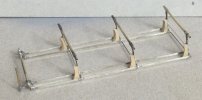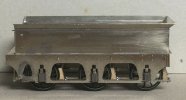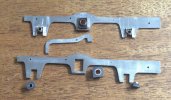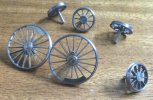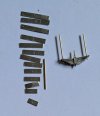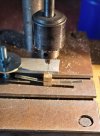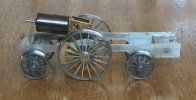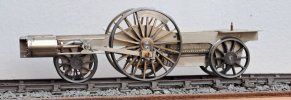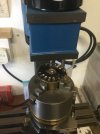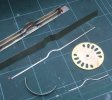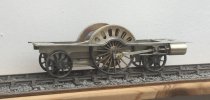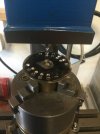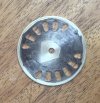Ian@StEnochs
Western Thunderer
After about 10 years of off and on activity my S7 version of the Austrian Goods is ready to paint. Something I am not rushing to do but I do intend painting it before the advertised kit goes on sale!
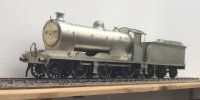
Concurrently I have been planning my next project and have been inspired by Nick Dunhill’s Stirling 8’ single thread. However, attractive though they are, an 8’ single just doesn’t fit with my main modelling interest, the Sou’West.
Everyone knows Patrick Stirling was the engineer on the GNR at the time of the railway races and the success of the singles is legendary. What is less well known is that before Doncaster he developed his skills at Kilmarnock and designed and had built there 3 classes of Single driver locomotive, He also built various other engines and kept the myriad of earlier ‘primitive’ machines working until his were ready. I need an example of Patrick’s engines to join my collection so a single is an ideal choice.
The early days of the G&SW are not well served with information, few photographs exist and what drawings that have survived are lacking details. Ahrons produced some side views for his Railway Magazine articles, later combined in a book and David Smith used them in his work on G&SWR locomotives.
This the 2 class with 6’6” wheels.
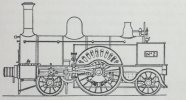
and this the last design, 45 class with 7’ wheels
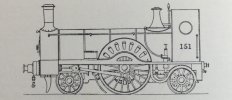
These combined with what GAs I have gathered has given me a start but it is this one I am building seen here in the early1880s. No 40 of the 40 class which was a development of the 2 class but here as rebuilt/reboilered by Patrick’s Brother James
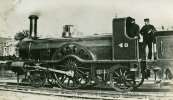
Not many folk remember that Patrick is part of the Stirling family of engineers. His Father, Robert, was a Church of Scotland minister but also the inventor of the Hot Air engine. James his younger brother followed him as loco engineer at Kilmarnock before moving on to the South Eastern Railway. His nephew Mathew was locomotive engineer on the Hull and Barnsley.
I have some drawings, a photograph and a fair bit of experience of building G&SW locomotives so have picked up a working knowledge of that railways standards and practice. This won’t be a 100% accurate model but it will be as near as I can get. Knowing my luck a full set of plans will appear just when I finish, just like the Austrian goods!
Most of these engines started out with 4 wheeled tenders but that behind 40 is easily identified as a 1500 gallon 6 wheeler and I have already built one of those to run with my J Stirling 8 class 2-4-0. Luckily I made extra parts so I had in stock almost a complete tender kit. I always try to make the boring bits first so having that done has got this project off to a flying start!
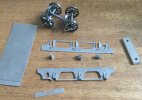
It wasn’t all straightforward as the frames I had had different cutouts at the front so I have had to fill in and recut, looks a bit scabby but I am sure will be ok once painted.
The tank is built on a basic, crude, framework of plate stiffened with bits of 4mm rail which will will never be seen.
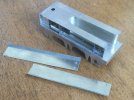
All wheels are carried in outside bearing boxes with coil springs. Next tender job is the boring brakes.
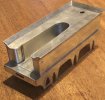
Ian.

Concurrently I have been planning my next project and have been inspired by Nick Dunhill’s Stirling 8’ single thread. However, attractive though they are, an 8’ single just doesn’t fit with my main modelling interest, the Sou’West.
Everyone knows Patrick Stirling was the engineer on the GNR at the time of the railway races and the success of the singles is legendary. What is less well known is that before Doncaster he developed his skills at Kilmarnock and designed and had built there 3 classes of Single driver locomotive, He also built various other engines and kept the myriad of earlier ‘primitive’ machines working until his were ready. I need an example of Patrick’s engines to join my collection so a single is an ideal choice.
The early days of the G&SW are not well served with information, few photographs exist and what drawings that have survived are lacking details. Ahrons produced some side views for his Railway Magazine articles, later combined in a book and David Smith used them in his work on G&SWR locomotives.
This the 2 class with 6’6” wheels.

and this the last design, 45 class with 7’ wheels

These combined with what GAs I have gathered has given me a start but it is this one I am building seen here in the early1880s. No 40 of the 40 class which was a development of the 2 class but here as rebuilt/reboilered by Patrick’s Brother James

Not many folk remember that Patrick is part of the Stirling family of engineers. His Father, Robert, was a Church of Scotland minister but also the inventor of the Hot Air engine. James his younger brother followed him as loco engineer at Kilmarnock before moving on to the South Eastern Railway. His nephew Mathew was locomotive engineer on the Hull and Barnsley.
I have some drawings, a photograph and a fair bit of experience of building G&SW locomotives so have picked up a working knowledge of that railways standards and practice. This won’t be a 100% accurate model but it will be as near as I can get. Knowing my luck a full set of plans will appear just when I finish, just like the Austrian goods!
Most of these engines started out with 4 wheeled tenders but that behind 40 is easily identified as a 1500 gallon 6 wheeler and I have already built one of those to run with my J Stirling 8 class 2-4-0. Luckily I made extra parts so I had in stock almost a complete tender kit. I always try to make the boring bits first so having that done has got this project off to a flying start!

It wasn’t all straightforward as the frames I had had different cutouts at the front so I have had to fill in and recut, looks a bit scabby but I am sure will be ok once painted.
The tank is built on a basic, crude, framework of plate stiffened with bits of 4mm rail which will will never be seen.

All wheels are carried in outside bearing boxes with coil springs. Next tender job is the boring brakes.

Ian.

